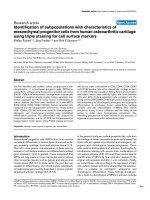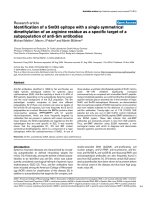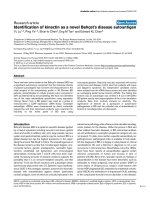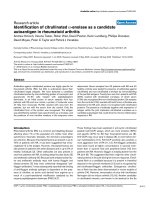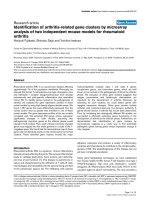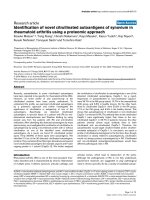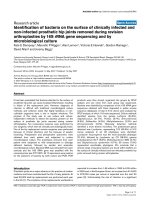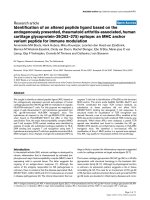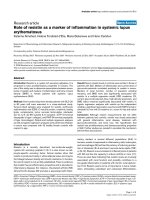Báo cáo y học: "Identification of kinectin as a novel Behçet''''s disease autoantigen" doc
Bạn đang xem bản rút gọn của tài liệu. Xem và tải ngay bản đầy đủ của tài liệu tại đây (720.88 KB, 7 trang )
Open Access
Available online />R1133
Vol 7 No 5
Research article
Identification of kinectin as a novel Behçet's disease autoantigen
Yu Lu
1,2
, Ping Ye
1,2
, Shun-le Chen
2
, Eng M Tan
1
and Edward KL Chan
3
1
Department of Molecular and Experimental Medicine, The Scripps Research Institute, La Jolla, CA, USA
2
Department of Rheumatology, Shanghai Ren Ji Hospital affiliated to Shanghai Second Medical University, Shanghai, China
3
Department of Oral Biology, University of Florida, Gainesville, FL, USA
Corresponding authors: Yu Lu, Edward KL Chan,
Received: 14 May 2005 Revisions requested: 15 Jun 2005 Revisions received: 23 Jun 2005 Accepted: 4 Jul 2005 Published: 27 Jul 2005
Arthritis Research & Therapy 2005, 7:R1133-R1139 (DOI 10.1186/ar1798)
This article is online at: />© 2005 Lu et al.; licensee BioMed Central Ltd.
This is an Open Access article distributed under the terms of the Creative Commons Attribution License ( />2.0), which permits unrestricted use, distribution, and reproduction in any medium, provided the original work is properly cited.
Abstract
There has been some evidence that Behçet's disease (BD) has
a significant autoimmune component but the molecular identity
of putative autoantigens has not been well characterized. In the
initial analysis of the autoantibody profile in 39 Chinese BD
patients, autoantibodies to cellular proteins were uncovered in
23% as determined by immunoblotting. We have now identified
one of the major autoantibody specificities using expression
cloning. Serum from a BD patient was used as a probe to
immunoscreen a λZAP expression cDNA library. Candidate
autoantigen cDNAs were characterized by direct nucleotide
sequencing and their expressed products were examined for
reactivity to the entire panel of BD sera using
immunoprecipitation. Reactivity was also examined with normal
control sera and disease control sera from patients with lupus
and Sjögren's syndrome. Six independent candidate clones
were isolated from the cDNA library screen and were identified
as overlapping partial human kinectin cDNAs. The finding that
kinectin was an autoantigen was verified in 9 out of 39 (23%)
BD patient sera by immunoprecipitation of the in vitro translation
products. Sera from controls showed no reactivity. The
significance of kinectin as a participant in autoimmune
pathogenesis in BD and the potential use of autoantibody to
kinectin in serodiagnostics are discussed.
Introduction
Behçet's disease (BD) is a systemic vasculitic disease typified
by a triad of symptoms including recurrent oral ulcers, genital
ulcers and uveitis. In addition, skin, joint, large vessels, nervous
system and gastrointestinal systems may be involved. BD is a
global disease but has the highest prevalence in the region
along the ancient 'Silk Road' in China. The etiopathogenesis of
the disease remains unclear but microbial agent triggers, envi-
ronmental factors, genetic predisposition, neutrophil hyper-
function, endothelial cell dysfunction and immunological
abnormalities involving both T and B cells have been impli-
cated. Increasing amounts of research evidence supports the
possibility that it is an immune-mediated vasculitis, and that
abnormal T-cell and B-cell reactions and autoantigen-driven
autoimmunity play pivotal roles [1]. Systemic lupus erythema-
tosus (SLE) is the prototypic systemic autoimmune rheumatic
disease with autoantibodies against cellular (particularly
nuclear) antigens, some of which are critically implicated in the
autoimmune pathology while others provide valuable serodiag-
nostic markers for the disease. Unlike the picture in SLE and
other related rheumatic diseases, in BD, antinuclear antibod-
ies and antibodies to neutrophil cytoplasmic antigens etc. are
not present. To date, since neither a specific autoantibody nor
pathognomonic pathological index is available to help estab-
lish the diagnosis of BD, it is largely or solely based on clinical
manifestations [2], and a dilemma in diagnosis is not a rare
occurrence in clinical practice. Nevertheless, since the 1960s,
there have been reports of autoantibodies against certain
unknown components of human oral mucosa in sera of
patients with BD. Since then, sporadic reports on findings of
autoantibodies in this disease have been described, such as
antibodies to retinal antigen(s), heat shock protein (HSP) of
some strains of Streptococcus sanguis cross-reactive with
human HSP polypeptide [3], antibodies to endothelial cell anti-
gens (AECA) and antibodies to α-tropomyosin [4,5], attesting
to the complicated humoral immune disorders in this disease.
AECA = antibody to endothelial cell antigen; BD = Behçet's disease; DMEM = Dulbecco's modified Eagle's medium; HCC = hepatocellular carci-
noma; HSP = heat shock protein; IIF = indirect immunofluorescence; PBS = phosphate buffered saline; SjS = Sjögren's syndrome; SLE = systemic
lupus erythematosus.
Arthritis Research & Therapy Vol 7 No 5 Lu et al.
R1134
This investigation was aimed at defining target cellular autoan-
tigens using time-tested and well-established molecular tech-
niques. Immunoscreening of expression libraries using BD
sera was used since this approach has been successfully
employed in the characterization of many clinically relevant
antigens in systemic rheumatic diseases such as SS-A/Ro [6-
9] and SS-B/La [10] antigens in Sjögren's syndrome (SjS)
and centromere antigen CENP-B [11] in scleroderma. In addi-
tion, we have been successful in using this strategy to identify
interesting autoantigens that have other biological signifi-
cance. Examples of these include NOR90/hUBF [12], p80-
coilin [13], Golgi autoantigens [14-16] and, more recently,
GW182 [17].
Materials and methods
Patients and sera
The currently used empirical criteria for the diagnosis of BD in
this study were the criteria proposed by the International Study
Group for BD (abbreviated as 'International Criteria') [2]. The
study subjects of 39 Chinese BD patients comprised 17
males and 22 females, mean age 37 ± 11.3 years old, who
were divided into two subgroups: 25 typical BD patients
(Group I, satisfying the International Criteria) and 14 clinically
diagnosed BD patients who had recurrent oral ulcers and one
of the symptoms of genital ulcers, eye symptoms or skin
lesions as defined by the International Criteria, as well as addi-
tional symptom(s) closely related to BD as listed in the Interna-
tional Criteria, that is, gastrointestinal ulcerations, deep vein
thrombosis or arthralgia/arthritis without evidence that the lat-
ter symptoms might be related to any other disease (Group II,
defined as 'probable BD' in this study). Disease controls
included 10 patients with SLE and 10 with SjS, all satisfying
corresponding international classification criteria. All BD
patients and disease controls involved in the study were
patients treated at the Rheumatology Department of Ren Ji
Hospital, Shanghai, China, where their clinical data and serum
samples were collected. Twenty normal control sera were ran-
domly selected from healthy blood donors working in the same
hospital. This study was approved by the institution review
board of Ren Ji Hospital which is affiliated with Shanghai Sec-
ond Medical University, and each patient involved gave
informed consent. All serum samples were preserved at -20°C
or -70°C until use.
Cell lines and cell extracts
HeLa (ATCC CCL 2.2) and T24 (human transitional cell blad-
der carcinoma) were obtained from the American Type Culture
Collection (Rockville, MD, USA). A bovine aortic endothelial
cell line was kindly provided by Dr Eugene G Levin from the
Scripps Research Institute (La Jolla, CA, USA). Cells were cul-
tured in DMEM containing 10% calf serum, harvested and
extracted in Buffer A (150 mM NaCl, 10 mM Tris-HCl, pH7.2,
0.5% Nonidet P-40) with protease inhibitor (Complete™; Boe-
hringer Mannheim, Indianapolis, IN, USA). For the preparation
of whole cell extract, 10 volumes of Laemmli gel sample buffer
[18] were added to the cell pellet, boiled for 3 min and stored
at -20°C until use.
Western blot
Whole cell lysates from bovine aortic endothelial cell, HeLa
and T24 cells were resolved individually by discontinuous
7.5% gel SDS-PAGE according to Laemmli's method [18].
Immunoblotting was performed as described by Towbin et al.
[19] with modifications. Nitrocellulose strips were blocked
with 3% nonfat milk in PBS containing 0.05% Tween-20
(PBS-T) and then incubated with BD patient sera and normal
control sera (1:100 dilution) at room temperature for 1 h. Fil-
ters were washed extensively with PBS-T to remove any
unbound antibodies. Bound antibodies were detected with
polyvalent, peroxidase-conjugated goat anti-human Ig and vis-
ualized by incubating the nitrocellulose strips in chemilumines-
cent reagents (NEN Life Science Products Inc., Boston, MA,
USA) and exposing to Kodak XAR-5 films.
Screening of phage cDNA expression library with
antibody probes
Serum from a BD patient showing the highest antibody titer in
immunoblotting was selected as a probe and used at a dilution
of 1:300 for initial immunoscreening of approximately 10
6
recombinants from a T24 cDNA expression library. The latter
was constructed in λZAPExpress vector (Stratagene, La Jolla,
CA, USA) and screened as previously described [20-22]. All
screenings were performed on duplicate isopropyl β-D-thioga-
lactoside (IPTG) pre-impregnated nitrocellulose filters, and
immunoreactive clones were detected by chemiluminescence.
Positive phages were subsequently plaque purified to 100%
by two repeated rounds of screening at low plaque densities.
Before screening the cDNA library, the BD serum was exten-
sively adsorbed against bacteria and wild-type λZAP phage
mixture to reduce background binding.
Analysis of candidate cDNAs
Purified candidate plaques were subcloned in vivo into pBK-
CMV plasmids using ExAssist™ helper phage as recom-
mended in the manufacturer's instructions (Stratagene). The
recombinant pBK-CMV plasmids were then purified using
QIAprep Spin Minprep Kit (Qiagen, Valencia, CA, USA).
Restriction enzyme digestion of plasmids with EcoRI and XhoI
and electrophoresis in a standard 1.0% agarose gel was used
to analyze the length of cDNA insert of each candidate plas-
mid. The complete nucleotide sequence was determined
using Bigdye terminator sequencing and a semi-automated
sequencer model 377 (ABI, Foster City, CA, USA). Both
nucleotide and deduced amino acid sequences were analyzed
for similarity with known sequences using BLAST search [23]
and ExPASy Proteomics tools />tools.html. Secondary structure analysis for coiled-coil motifs
was conducted with the software program COILS [24].
Available online />R1135
Immunoprecipitation of in vitro translation products
Candidate cDNA clones were used as templates for in vitro
transcription and translation and the products were used as
substrates for immunoprecipitation to confirm the specificity of
reaction with BD sera. In brief, 1 µg of the pBK-CMV plasmid
identified in the screening outlined above was added as tem-
plate in a 50-µl reaction for the coupled in vitro transcription
and translation reaction with a rabbit reticulocyte lysate system
(Promega, Madison, WI, USA) in the presence of
35
S-methio-
nine (Trans-
35
S label; ICN Biochemicals, Costa Mesa, CA,
USA) and RNasin
®
Ribonuclease Inhibitor (Stratagene) as
recommended by the manufacturer (Promega). Translation
was carried out at 30°C for 1.5 h. Products were analyzed in
a 12.5% gel SDS-PAGE and stored at -80°C for further immu-
noprecipitation analysis. The in vitro translation proteins were
examined for reactivity by sera using immunoprecipitation
described [8,25].
Results and discussion
Autoantibody detection in sera from BD patients
Initial examination of a group of 39 BD patients using indirect
immunofluorescence (IIF) on a HEp-2 cell substrate did not
yield any characteristic nuclear or cytoplasmic staining pat-
terns. BD is thought by some to be a vasculitic disease involv-
ing pathophysiology of endothelial cells, and antibody to
endothelial cell antigen (AECA) has been reported. Reports
on the prevalence of AECA have varied largely and alpha-eno-
lase was reported as one of the putative target antigens [26].
In this study, the use of bovine aortic endothelial cells as sub-
strate for IIF did not provide any additional data. However,
Western blot analysis of the BD sera began to show some
interesting autoreactivity using cell lysates from both HeLa and
bovine aortic endothelial cells. HeLa cells were initially used
for this analysis because they are commonly used in the labo-
ratory as Western blot substrate. Fig. 1 illustrates the common
reactivity to 49 kDa and 120 kDa proteins in the endothelial
cell lysates. These antigens were also detected in HeLa and
T24 cells; the latter cell line was analyzed because our labora-
tory at The Scripps Research Institute has produced an excel-
lent expression cDNA library from the T24 line and the positive
result with the T24 cell extracts allowed us to screen the T24
library. Ig isotype analysis showed that all reactivity was largely
IgG antibodies. Since the 49 kDa and 120 kDa bands were
observed in cell extracts from bovine as well as human cell
lines, these autoantigens might be evolutionarily conserved.
In total, nine out of 39 BD sera (23%) had autoantibody to the
49 kDa antigen and eight (20%) to the 120 kDa antigen. Four
BD sera (10%) reacted with both proteins. Additionally, sera
that showed common reactivity to the 120 kDa protein also
demonstrated a common band that migrated at ~150 kDa,
although it appeared weaker than the 120 kDa band. These
antigens appeared to have different molecular weights than
those of the known autoantigens in systemic rheumatic dis-
eases. In addition, other reactive bands were detected but
they were not as commonly shared as the 49 kDa and 120 kDa
bands. The 49 kDa protein was shown to be distinct from 48
kDa SS-B/La or 50 kDa Jo-1 proteins (Fig. 1). The 120 kDa
antigen was also shown to migrate differently from alanyl tRNA
synthetase in another Western blot analysis (data not shown)
and did not share any apparent crossreactive epitopes with
the 49 kDa antigen. Western blot analyses of 20 normal con-
trol sera did not show the reactivities observed with BD sera.
In order to further characterize these autoreactivities, a serum
sample from the Group I definitive BD patients with the strong-
est reactivity to 49 kDa and 120 kDa antigens (Fig. 1, lane 2)
was selected as antibody probe for expression library
screening.
Kinectin identified as a novel BD autoantigen
After screening 500,000 clones from the T24 cell λZAPEx-
press expression library, seven immunoreactive clones were
isolated and plaque purified in two to three rounds to achieve
Figure 1
Western blot analysis of autoantibodies in selected BD seraWestern blot analysis of autoantibodies in selected BD sera. Whole
cell extracts from bovine aortic endothelial cells were separated by a
7.5% gel SDS-PAGE, transferred to nitrocellulose and probed with
serum dilutions of 1:100. Several sera showed reactivity to proteins of
49, 120 and 150 kDa. The serum in lane 2 with the strongest reactivity
to the 49 kDa and 120 kDa bands was selected as the probe for the
expression library screening. Molecular mass markers are shown on the
left. NHS represents the normal control. BD, Behçet's disease.
Arthritis Research & Therapy Vol 7 No 5 Lu et al.
R1136
100% homogeneity. The cDNA inserts were subcloned in vivo
into pBK-CMV plasmids, analyzed by restriction digestion
using EcoRI and XhoI enzymes, and submitted to direct nucle-
otide sequencing across the polylinker arms. The cDNA
inserts represented six independent clones designated BD41
(identical to BD44), BD481, BD42, BD47, BD482 and BD49.
Their identities were established as overlapping partial cDNAs
of human kinectin, ranging from 1.9 kb to 3 kb (Fig. 2a). The
full-length human kinectin (GenBank accession number
NM_182926
[27]) has 4,816 bases containing an open read-
ing frame coding 1,357 amino acid residues with molecular
mass 156 kDa. All six cDNAs lacked the 5' portion of the
kinectin sequence to different degrees but spanned a
sequence of kinectin that extended to the 3'-untranslated
region. Secondary structure analysis of kinectin protein using
the program COILS identified a long region of α-helical coiled-
coil domain that extended from amino acid residue 327 to the
C-terminus (Fig. 2a, hatched boxes). In vitro coupled tran-
scription and translation of BD44 and BD42 clones directed
the synthesis of [
35
S]-methionine-labeled polypeptides that
migrated at 95 and 60 kDa, respectively, in addition to smaller
polypeptides (Fig. 2b). These products had predicted molec-
ular weights of 103 kDa and 75 kDa.
Kinectin was initially identified in chick embryo brain micro-
some as an integral membrane protein anchored in endoplas-
mic reticulum and involved in kinesin-driven vesicle motility
along microtubules [28,29]. Kinectin consists of a 120-kDa
and a 160-kDa polypeptide interacting through the α-helical
coiled-coil domain to form a heterodimer [30]. The full-length
kinectin is the 160 kDa polypeptide containing an N-terminal
transmembrane helix followed by a bipartite nuclear localiza-
tion sequence and two C-terminal leucine zipper motifs. We
presume that the 120 kDa polypeptide detected in Western
blot (Fig. 1) is the truncated version of the 160-kDa polypep-
tide, lacking the N-terminal first 232 amino acids [30]. The N-
terminus of the 160-kDa polypeptide consists of a transmem-
brane domain that anchors kinectin to endoplasmic reticulum
[30,31]. This 120 kDa polypeptide is probably the predomi-
nant form detected in the Western blot analysis (Fig. 1)
because of its preferential solubility due to the omission of the
N-terminal transmembrane domain.
Other functions for kinectin have been reported. Yeast two-
hybrid screen studies from several laboratories have revealed
the interaction of the Rho family of GTPase with kinectin, and
have shown the functional links among RhoG, kinectin and
kinesin, with kinectin as a key effector of RhoG microtubule-
dependent cellular activity [32]. Kinectin was also identified as
an important constituent of integrin-based adhesion com-
plexes, which link integrins to the cytoskeleton and recruit sig-
naling molecules [33]. A new study reported that a kinectin
isoform lacking a major portion of the kinesin-binding domain
is very probably the most conservative form of kinectin; it does
not bind kinesin but act as a membrane anchor for the transla-
tion elongation factor-1 delta in the endoplasmic reticulum
[34].
Prevalence and specificity of anti-kinectin
autoantibodies
The in vitro [
35
S]-methionine-labeled translation product of
BD44, representing the largest recombinant kinectin fragment
available, was used as the antigen substrate in an immunopre-
cipitation assay. Out of 39 BD patient sera, nine (23%) recog-
nized the BD44 translation product (Fig. 3), whereas sera from
20 normal controls, 10 SLE and 10 SjS patients did not show
Figure 2
cDNA clones obtained from expression library screen using a BD serumcDNA clones obtained from expression library screen using a BD serum. (a) Schematic diagram of the six overlapping cDNAs aligned with pub-
lished human full-length kinectin sequence (4,816 bp, GenBank accession number NM_182926
, shown on top). The open box represents the cod-
ing region of the full-length kinectin protein of ~156 kDa. cDNA inserts from the six independent clones BD41/BD44, BD481, BD42, BD47, BD482
and BD49 represent N-terminal truncations and are predicted as coiled-coil domains (hatched). Ќ represents short sequences derived from alterna-
tive mRNA splicing in the 3'-untranslated region. (b) Autoradiography of in vitro transcription and translation products of the candidate clones BD44
and BD42 labeled by [
35
S]-methionine and analyzed on a 12.5% gel SDS-PAGE. Products of BD44 and BD42 gave major bands with the highest
molecular mass of 95 kDa and 60 kDa, respectively. The lane marked as p90 represents an unrelated autoantigen used as a positive control for the
in vitro translation reaction. Molecular markers are shown on the left. BD, Behçet's disease.
Available online />R1137
reactivity. Among the nine anti-kinectin positive patients, six (6/
25, 24%) were from Group I (definitive BD) including the BD
patient whose serum was used in the immunoscreening of
expression cDNA library, and three (3/14, 21.4%) patients
were from the Group II (probable BD) in this study. According
to the Fisher Exact Probability calculation (P = 1.00), there is
no statistically significant difference for antibody to kinectin
between the two groups. The combined data substantiated
the finding that kinectin is an autoantigen that can be recog-
nized by sera from 23% of Chinese BD patients in this study
with at least one immunoreactive region or autoepitope resid-
ing within the BD44 encoded polypeptide.
Currently, there are more than six diagnostic/classification cri-
teria for BD, among which the International Criteria have been
applied most extensively due to its relatively high sensitivity
(91%) and specificity (96%) [2]. As discussed above, differen-
tial diagnosis of BD might be confusing in clinical practice
since no specific laboratory test is available, and some
patients may have symptoms and signs strongly suggestive of
BD but do not fully satisfy the International Criteria, as in the
Group II (probable BD) patients in our study group. A number
of investigators have pointed out that a comprehensive analy-
sis of the clinical data for a given patient is very important for
correct clinical diagnosis of BD, and that classification/diag-
nosis criteria, including the International Criteria, should be fol-
lowed but should not be exclusive. The observation that three
out of 14 patients in the probable BD group also had antibody
to kinectin and the similar percentage of positive reactors
between this group and Group I (21.4% versus 24%) sup-
ports this notion. The further use of non-clinical parameters
such as immunological biomarkers as adjuncts to identify BD
patients could be of help in the classification of this disease
entity
While our work was ongoing, anti-kinectin antibodies were
reported in sera from patients with hepatocellular carcinoma
(HCC) [35,36] and aplastic anemia [37,38]. The first HCC
report [35] identified kinectin as a tumor-associated antigen
from the screening of an autologous cDNA library constructed
from the cancer of a 30-year-old patient from Guangxi, China.
This report stated that four out of five HCC patients tested
were positive for anti-kinectin antibody [35]. In 2004, another
laboratory also reported the cloning of kinectin as a tumor-
associated antigen from a (presumably) different 30-year-old
Chinese HCC patient [36]. In contrast, anti-kinectin antibodies
were not detected in other studies of HCC patients
associated with our laboratory [39,40]. The reports of anti-
kinectin antibodies in aplastic anemia are also very interesting
[37,38]. The initial report by Hirano et al. identified kinectin by
screening an aplastic anemia patient for candidate antigens
using a Clontech human fetal liver cDNA expression library
and it was concluded that seven out of 18 aplastic anemia
patients were positive for anti-kinectin while none of the nor-
mal or disease controls had this antibody [37]. In their recent
report, Hirano et al. reported that anti-kinectin antibodies were
found in 39% of aplastic anemia patients from the United
States but only in three out of 30 (10%) cases in Japan [38].
In our study reported here, kinectin antibodies were only
detected in BD patients and not in normal controls and SLE
and SjS disease controls. None of the BD patients with anti-
kinectin had signs of HCC or aplastic anemia at the time of
Figure 3
Immunoprecipitation analysis of the 39 BD patients for autoantibody to kinectinImmunoprecipitation analysis of the 39 BD patients for autoantibody to kinectin. In vitro translation products of kinectin cDNA BD44 template was
used as the substrate. Nine out of the 39 BD patient sera (23%, lanes 1–39) immunoprecipitated the BD44 translation products. Molecular weight
standards are shown on the left. The lane marked 'Total' shows the labeled translation product alone for comparison. Lanes NHS1, NHS2, NHS3,
NHS4 are the four normal controls. BD, Behçet's disease.
Arthritis Research & Therapy Vol 7 No 5 Lu et al.
R1138
diagnosis and at up to 4 years of follow-up. Mapping of
epitope(s) recognized by anti-kinectin antibodies may shed
light on the question of whether different autoepitopes reside
within the kinectin molecule recognized by sera from different
diseases.
Kinectin – a new member of coiled-coil cytoplasmic
autoantigens
We have recently reviewed the literature on the growing
number of cytoplasmic autoantigens rich in α-helical coiled-
coil domains as typified from our study of Golgi autoantigens
[41]. Golgi autoantigens are generally high molecular weight
proteins between 100 and 350 kDa and rich in coiled-coil
domains in the central region with non-coiled-coil or globular
domains at both N and C termini. Golgi autoantigens are dis-
played on the cytoplasmic face of the Golgi complex and are
not localized to apoptotic blebs during apoptosis [42]. Gian-
tin, the highest molecular weight Golgi autoantigen reported,
is the predominant target of human anti-Golgi complex anti-
bodies and multiple non-cross-reactive epitopes have been
mapped spanning the 350 kDa protein [43]. Other high
molecular weight autoantigens with similar features have been
reported in cytoplasmic and mitotic organelles suggesting that
these selected proteins become autoimmunogenic based on
their subcellular association and molecular features [41]. For
example, in the endosomal compartment, the two known
autoantigens are early endosomal protein EEA1 (180 kDa)
[44] and CLIP-170 (170 kDa) [45]. There is also a series of
centrosomal autoantigens identified as coiled-coil-rich pro-
teins including pericentrin, a 220 kDa protein [46], ninein, a
protein with alternatively spliced products of 245 and 249 kDa
[47], Cep250 (250 kDa) and Cep110 (110 kDa) [48]. Centro-
mere autoantigens have been described but the two interest-
ing ones related to this discussion are CENP-E [49] and
CENP-F [50]; both are high molecular weight proteins (312 to
400 kDa) and have the same type of overall structure as dis-
cussed above. NuMA is another large coiled-coil protein
located at the mitotic spindle pole and is the most common tar-
get autoantigen in sera with mitotic spindle apparatus staining
[51]. Non-muscle myosin (~200 kDa) is a cytoskeletal autoan-
tigen [52] that falls in the same group of high molecular weight
and coiled-coil-rich autoantigens. These endosomal, centro-
somal, mitotic apparatus and intracellular autoantigens are,
like the golgins, proteins with high molecular weights and an
overall high content of coiled-coil domains. The combination of
these two physical features in autoantigens may contribute to
the induction and production of autoimmune antibodies in cer-
tain disease states. Kinectin is an integral membrane protein
largely confined to the endoplasmic reticulum [28,31] and it
fits into this new category of autoantigens that are large coiled-
coil rich proteins (≥100 kDa) in the cytoplasm.
Conclusion
Here we report the detection of kinectin autoantibody in 23%
of Chinese patients with BD. The identity of kinectin as a BD-
related autoantigen has not been reported to date.
Autoantibody reaction against kinectin in BD observed in this
study further confirms the autoimmune involvement in BD and
may provide new inroads into elucidating the immunopatho-
genesis of the disease. In an effort to clarify the association of
BD with antibody to kinectin, it is essential to measure anti-
body to kinectin in larger patient populations including both
BD, probable BD and important autoimmune rheumatic dis-
eases such as SLE, SjS, rheumatoid arthritis etc., as well as
those diseases not easily differentiated from BD, such as
recurrent aphthous oral ulcer, Reiter's syndrome, inflammatory
bowel diseases etc. On the other hand, further analysis of the
association of anti-kinectin antibody with different manifesta-
tions or disease 'subtypes' of BD is another important project.
Anti-kinectin is clearly only one of the antigen-antibody sys-
tems identified because there were many other antibodies
observed in the Western blot analysis of BD sera. Using other
sera for immunoscreening would probably lead to the identifi-
cation of other potentially important antigen-antibody systems.
Competing interests
The authors declare that they have no competing interests.
Authors' contributions
YL performed the study and drafted the manuscript. PY pro-
vided technical help throughout the study. SLC and EMT con-
ceived the study, participated in the design and helped in the
analysis of the data. EKLC participated in the design of the
study, interpreted data and helped to draft the manuscript. All
authors read and approved the final manuscript.
Acknowledgements
This work was supported in part by National Institutes of Health Grants
AI39645, AR42455, AI47859 (EKLC) and CA56956 (EMT), and
National Nature Science Foundation of China Grant 30271225 (SLC).
References
1. Hirohata S, Kikuchi H: Behcet's disease. Arthritis Res Ther 2003,
5:139-146.
2. Criteria for diagnosis of Behcet's disease. International Study
Group for Behcet's Disease. Lancet 1990, 335:1078-1080.
3. Lehner T: The role of heat shock protein, microbial and autoim-
mune agents in the aetiology of Behcet's disease. Int Rev
Immunol 1997, 14:21-32.
4. Mor F, Weinberger A, Cohen IR: Identification of alpha-tropomy-
osin as a target self-antigen in Behcet's syndrome. Eur J
Immunol 2002, 32:356-365.
5. Mahesh SP, Li Z, Buggage R, Mor F, Cohen IR, Chew EY, Nussen-
blatt RB: Alpha tropomyosin as a self-antigen in patients with
Behcet's disease. Clin Exp Immunol 2005, 140:368-375.
6. Ben-Chetrit E, Gandy BJ, Tan EM, Sullivan KF: Isolation and char-
acterization of a cDNA clone encoding the 60-kD component
of the human SS-A/Ro ribonucleoprotein autoantigen. J Clin
Invest 1989, 83:1284-1292.
7. Deutscher SL, Harley JB, Keene JD: Molecular analysis of the
60-kDa human Ro ribonucleoprotein. Proc Natl Acad Sci USA
1988, 85:9479-9483.
8. Chan EKL, Hamel JC, Buyon JP, Tan EM: Molecular definition
and sequence motifs of the 52-kD component of human SS-
A/Ro autoantigen. J Clin Invest 1991, 87:68-76.
9. Itoh K, Itoh Y, Frank MB: Protein heterogeneity in the human
Ro/SSA ribonucleoproteins. The 52- and 60-kD Ro/SSA
Available online />R1139
autoantigens are encoded by separate genes. J Clin Invest
1991, 87:177-186.
10. Chambers JC, Keene JD: Isolation and analysis of cDNA clones
expressing human lupus La antigen. Proc Natl Acad Sci USA
1985, 82:2115-2119.
11. Earnshaw WC, Sullivan KF, Machlin PS, Cooke CA, Kaiser DA,
Pollard TD, Rothfield NF, Cleveland DW: Molecular cloning of
cDNA for CENP-B, the major human centromere autoantigen.
J Cell Biol 1987, 104:817-829.
12. Chan EKL, Imai H, Hamel JC, Tan EM: Human autoantibody to
RNA polymerase I transcription factor hUBF. Molecular iden-
tity of nucleolus organizer region autoantigen NOR-90 and
ribosomal RNA transcription upstream binding factor. J Exp
Med 1991, 174:1239-1244.
13. Andrade LEC, Chan EKL, Raska I, Peebles CL, Roos G, Tan EM:
Human autoantibody to a novel protein of the nuclear coiled
body. Immunological characterization and cDNA cloning of
p80-coilin. J Exp Med 1991, 173:1407-1419.
14. Fritzler MJ, Hamel JC, Ochs RL, Chan EKL: Molecular character-
ization of two human autoantigens: Unique cDNAs encoding
95- and 160-kD proteins of a putative family in the Golgi
complex. J Exp Med 1993, 178:49-62.
15. Fritzler MJ, Lung CC, Hamel JC, Griffith K, Chan EKL: Molecular
characterization of golgin-245: a novel Golgi complex protein
containing a granin signature. J Biol Chem 1995,
270:31262-31268.
16. Griffith KJ, Chan EKL, Lung CC, Hamel JC, Guo X, Miyachi K, Frit-
zler MJ: Molecular cloning of a novel 97-kd Golgi complex
autoantigen associated with Sjögren's syndrome. Arthritis
Rheum 1997, 40:1693-1702.
17. Eystathioy T, Chan EKL, Tenenbaum SA, Keene JD, Griffith K, Frit-
zler MJ: A phosphorylated cytoplasmic autoantigen, GW182,
associates with a unique population of human mRNAs within
novel cytoplasmic speckles. Mol Biol Cell 2002,
13:1338-1351.
18. Laemmli UK: Cleavage of structural proteins during the assem-
bly of the head of bacteriophage T4. Nature 1970,
227:680-685.
19. Towbin H, Staehelin T, Gordon J: Electrophoretic transfer of pro-
teins from polyacrylamide gels to nitrocellulose sheets. Proce-
dure and some applications. Proc Natl Acad Sci USA 1979,
76:4350-4354.
20. Soo Hoo L, Zhang JY, Chan EKL: Cloning and characterization
of a novel 90 kDa 'companion' auto-antigen of p62 overex-
pressed in cancer. Oncogene 2002, 21:5006-5015.
21. Ochs RL, Muro Y, Si Y, Ge H, Chan EKL, Tan EM: Autoantibodies
to DFS70/transcriptional coactivator p75 in atopic dermatitis
and other conditions. J Allergy Clin Immunol 2000,
105:1211-1220.
22. Ochs RL, Stein TW Jr, Chan EKL, Ruutu M, Tan EM: cDNA cloning
and characterization of a novel nucleolar protein. Mol Biol Cell
1996, 7:1015-1024.
23. Altschul SF, Madden TL, Schaffer AA, Zhang J, Zhang Z, Miller W,
Lipman DJ: Gapped BLAST and PSI-BLAST: a new generation
of protein database search programs. Nucleic Acids Res 1997,
25:3389-3402.
24. Lupas A: Coiled coils: new structures and new functions.
Trends Biochem Sci 1996, 21:375-82.
25. Wang D, Buyon JP, Zhu W, Chan EKL: Defining a novel 75-kDa
phosphoprotein associated with SS-A/Ro and identification of
distinct human autoantibodies. J Clin Invest 1999,
104:1265-1275.
26. Lee KH, Chung HS, Kim HS, Oh SH, Ha MK, Baik JH, Lee S, Bang
D: Human alpha-enolase from endothelial cells as a target
antigen of anti-endothelial cell antibody in Behcet's disease.
Arthritis Rheum 2003, 48:2025-2035.
27. Futterer A, Kruppa G, Kramer B, Lemke H, Kronke M: Molecular
cloning and characterization of human kinectin. Mol Biol Cell
1995, 6:161-170.
28. Toyoshima I, Yu H, Steuer ER, Sheetz MP: Kinectin, a major
kinesin-binding protein on ER. J Cell Biol 1992,
118:1121-1131.
29. Kumar J, Yu H, Sheetz MP: Kinectin, an essential anchor for
kinesin-driven vesicle motility. Science 1995, 267:1834-1837.
30. Kumar J, Erickson HP, Sheetz MP: Ultrastructural and biochem-
ical properties of the 120-kDa form of chick kinectin. J Biol
Chem 1998, 273:31738-31743.
31. Yu H, Nicchitta CV, Kumar J, Becker M, Toyoshima I, Sheetz MP:
Characterization of kinectin, a kinesin-binding protein: primary
sequence and N-terminal topogenic signal analysis. Mol Biol
Cell 1995, 6:171-183.
32. Vignal E, Blangy A, Martin M, Gauthier-Rouviere C, Fort P: Kinec-
tin is a key effector of RhoG microtubule-dependent cellular
activity. Mol Cell Biol 2001, 21:8022-8034.
33. Tran H, Pankov R, Tran SD, Hampton B, Burgess WH, Yamada
KM: Integrin clustering induces kinectin accumulation. J Cell
Sci 2002, 115:2031-2040.
34. Ong LL, Er CP, Ho A, Aung MT, Yu H: Kinectin anchors the
translation elongation factor-1 delta to the endoplasmic
reticulum. J Biol Chem 2003, 278:32115-32123.
35. Stenner-Liewen F, Luo G, Sahin U, Tureci O, Koslovski M, Kautz I,
Liewen H, Pfreundschuh M: Definition of tumor-associated anti-
gens in hepatocellular carcinoma. Cancer Epidemiol Biomark-
ers Prev 2000, 9:285-290.
36. Wang HC, Su YR, Han KJ, Pang XW, Peng JR, Liang B, Wang S,
Chen WF: Multiple variants and a differential splicing pattern
of kinectin in human hepatocellular carcinoma. Biochem Cell
Biol 2004, 82:321-327.
37. Hirano N, Butler MO, Von Bergwelt-Baildon MS, Maecker B,
Schultze JL, O'Connor KC, Schur PH, Kojima S, Guinan EC,
Nadler LM: Autoantibodies frequently detected in patients with
aplastic anemia. Blood 2003, 102:4567-4575.
38. Hirano N, Butler MO, Guinan EC, Nadler LM, Kojima S: Presence
of anti-kinectin and anti-PMS1 antibodies in Japanese aplastic
anaemia patients. Br J Haematol 2005, 128:221-223.
39. Imai H, Nakano Y, Kiyosawa K, Tan EM: Increasing titers and
changing specificities of antinuclear antibodies in patients
with chronic liver disease who develop hepatocellular
carcinoma. Cancer 1993, 71:26-35.
40. Zhang JY, Casiano CA, Peng XX, Koziol JA, Chan EKL, Tan EM:
Enhancement of antibody detection in cancer using panel of
recombinant tumor-associated antigens. Cancer Epidemiol
Biomarkers Prev 2003, 12:136-143.
41. Nozawa K, Fritzler MJ, Chan EKL: Unique and shared features of
Golgi complex autoantigens. Autoimmun Rev 2005, 4:35-41.
42. Nozawa K, Casiano CA, Hamel JC, Molinaro C, Fritzler MJ, Chan
EKL: Fragmentation of Golgi complex and Golgi autoantigens
during apoptosis and necrosis. Arthritis Res 2002, 4:R3.
43. Nozawa K, Fritzler MJ, von Mühlen CA, Chan EKL: Giantin is the
major Golgi autoantigen in human anti-Golgi complex sera.
Arthritis Res Ther 2004, 6:R95-R102.
44. Selak S, Chan EKL, Schoenroth L, Senécal JL, Fritzler MJ: Early
endosome antigen. 1: An autoantigen associated with neuro-
logical diseases. J Investig Med 1999, 47:311-318.
45. Griffith KJ, Ryan JP, Senécal JL, Fritzler MJ: The cytoplasmic
linker protein CLIP-170 is a human autoantigen. Clin Exp
Immunol 2002, 127:533-538.
46. Doxsey SJ, Stein P, Evans L, Calarco PD, Kirschner M: Pericen-
trin, a highly conserved centrosome protein involved in micro-
tubule organization. Cell 1994, 76:639-50.
47. Bouckson-Castaing V, Moudjou M, Ferguson DJ, Mucklow S,
Belkaid Y, Milon G, Crocker PR: Molecular characterisation of
ninein, a new coiled-coil protein of the centrosome. J Cell Sci
1996, 109:179-190.
48. Mack GJ, Rees J, Sandblom O, Balczon R, Fritzler MJ, Rattner JB:
Autoantibodies to a group of centrosomal proteins in human
autoimmune sera reactive with the centrosome. Arthritis
Rheum 1998, 41:551-558.
49. Rattner JB, Rees J, Arnett FC, Reveille JD, Goldstein R, Fritzler MJ:
The centromere kinesin-like protein, CENP-E. An autoantigen
in systemic sclerosis. Arthritis Rheum 1996, 39:1355-1361.
50. Rattner JB, Rees J, Whitehead CM, Casiano CA, Tan EM, Humbel
RL, Conrad K, Fritzler MJ: High frequency of neoplasia in
patients with autoantibodies to centromere protein CENP-F.
Clin Invest Med 1997, 20:308-319.
51. Price CM, McCarty GA, Pettijohn DE: NuMA protein is a human
autoantigen. Arthritis Rheum 1984, 27:774-779.
52. von Mühlen CA, Chan EKL, Peebles CL, Imai H, Kiyosawa K, Tan
EM: Non-muscle myosin as target antigen for human autoan-
tibodies in patients with hepatitis C virus-associated chronic
liver diseases. Clin Exp Immunol 1995, 100:67-74.
